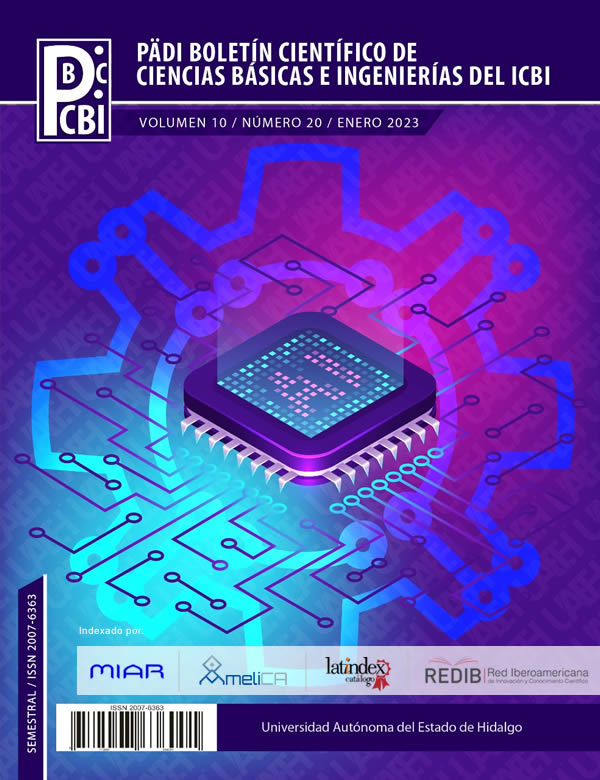Síntesis de partículas luminiscentes de carbono a partir de la carbonización de Beta Vulgaris (betabel)
DOI:
https://doi.org/10.29057/icbi.v10i20.9793Palabras clave:
Puntos cuánticos de carbono (CQDs), betabel, carbonizaciónResumen
Se desarrolló un método de síntesis efectivo, económico y amigable con el medio ambiente para la obtención de puntos cuánticos de carbono (CQDs) con propiedades luminiscentes mediante la carbonización de la beta vulgaris (betabel) a diferentes temperaturas y tiempos de operación, sin utilizar algún otro reactivo y empleando agua como único disolvente. Los CQDs obtenidos mostraron fluorescencia mayoritariamente en azul al ser expuestos a una lampara de radiación ultravioleta de 254 nm de longitud de onda y mediante el análisis por espectroscopia infrarroja por transformadas de Fourier se identificaron a los grupos carboxilato presentes en la superficie de las nanopartículas como los responsables de las propiedades luminiscentes a los CQDs.
Descargas
Información de Publicación
Perfiles de revisores N/D
Declaraciones del autor
Indexado en
- Sociedad académica
- N/D
Citas
An, Q., Lin, Q., Huang, X., Zhou, R., Guo, X., Xu, W., Wang, S., Xu, D., & Chang, H. T. (2021). Electrochemical synthesis of carbon dots with a Stokes shift of 309 nm for sensing of Fe3+ and ascorbic acid. Dyes and Pigments, 185(PA), 108878. https://doi.org/10.1016/j.dyepig.2020.108878
Baião, D. dos S., da Silva, D. V. T., & Paschoalin, V. M. F. (2020). Beetroot, a remarkable vegetable: Its nitrate and phytochemical contents can be adjusted in novel formulations to benefit health and support cardiovascular disease therapies. Antioxidants, 9(10), 1–36. https://doi.org/10.3390/antiox9100960
Cao, Y., Wang, X., Bai, H., Jia, P., Zhao, Y., Liu, Y., Wang, L., Zhuang, Y., & Yue, T. (2022). Fluorescent detection of tetracycline in foods based on carbon dots derived from natural red beet pigment. Lwt, 157, 113100. https://doi.org/10.1016/j.lwt.2022.113100
Chhikara, N., Kushwaha, K., Sharma, P., Gat, Y., & Panghal, A. (2019). Bioactive compounds of beetroot and utilization in food processing industry: A critical review. Food Chemistry, 272, 192–200. https://doi.org/10.1016/j.foodchem.2018.08.022
Clifford, T., Howatson, G., West, D. J., & Stevenson, E. J. (2015). The potential benefits of red beetroot supplementation in health and disease. Nutrients, 7(4), 2801–2822. https://doi.org/10.3390/nu7042801
Cui, L., Ren, X., Wang, J., & Sun, M. (2020). Synthesis of homogeneous carbon quantum dots by ultrafast dual-beam pulsed laser ablation for bioimaging. Materials Today Nano, 12, 100091. https://doi.org/10.1016/j.mtnano.2020.100091
El-Shabasy, R. M., Elsadek, M. F., Ahmed, B. M., Farahat, M. F., Mosleh, K. M., & Taher, M. M. (2021). Recent developments in carbon quantum dots: Properties, fabrication techniques, and bio-applications. Processes, 9(2), 1–24. https://doi.org/10.3390/pr9020388
Feng, X., & Zhang, Y. (2019). A simple and green synthesis of carbon quantum dots from coke for white light-emitting devices. RSC Advances, 9(58), 33789–33793. https://doi.org/10.1039/c9ra06946a
Jelinek, R. (2017). Carbon Quantum Dots. Synthesis, Properties and Applicatons. Springer. https://doi.org/10.1007/978-3-319-43911-2
Kurian, M., & Paul, A. (2021). Recent trends in the use of green sources for carbon dot synthesis–A short review. Carbon Trends, 3, 100032. https://doi.org/10.1016/j.cartre.2021.100032
Li, X. (2017). The Role of Functional Groups in Carbon Dots ’ Emission and Sensing Applications [Griffith University]. https://doi.org/doi.org/10.25904/1912/411
Lim, S. Y., Shen, W., & Gao, Z. (2015). Carbon quantum dots and their applications. Chemical Society Reviews, 44(1), 362–381. https://doi.org/10.1039/c4cs00269e
Luo, J., Sun, Z., Zhou, W., Mo, F., Wu, Z. chao, & Zhang, X. (2021). Hydrothermal synthesis of bright blue-emitting carbon dots for bioimaging and fluorescent determination of baicalein. Optical Materials, 113(December 2020), 110796. https://doi.org/10.1016/j.optmat.2020.110796
Ma, C., Yin, C., Fan, Y., Yang, X., & Zhou, X. (2019). Highly efficient synthesis of N-doped carbon dots with excellent stability through pyrolysis method. Journal of Materials Science, 54(13), 9372–9384. https://doi.org/10.1007/s10853-019-03585-7
Mancha Flores, M. A., Rentería Monterrubio, A. L., Sánchez Vega, R., & Chávez Martínez, A. (2019). ESTRUCTURA Y ESTABILIDAD DE LAS BETALAÍNAS. Interciencia, 44(6), 318–325. https://www.redalyc.org/articulo.oa?id=33960068002
Nasrollahzadeh, M., Sajjadi, M., & Sajadi, S. M. (2019). Green Nanotechnology. In An Introduction to Green Nanotechnology (1st ed., Vol. 28, pp. 145–198). Elsevier Ltd. https://doi.org/10.1016/B978-0-12-813586-0.00005-5
Neagu, C., & Barbu, V. (2014). Principal component analysis of the factors involved in the extraction of beetroot betalains. Journal of Agroalimentary Processes and Technologies, 20(4), 311–318.
Perumal, S., Atchudan, R., Edison, T. N. J. I., & Lee, Y. R. (2021). Sustainable synthesis of multifunctional carbon dots using biomass and their applications: A mini-review. Journal of Environmental Chemical Engineering, 9(4), 105802. https://doi.org/10.1016/j.jece.2021.105802
Wang, Y., & Hu, A. (2014). Carbon quantum dots: Synthesis, properties and applications. Journal of Materials Chemistry C, 2(34), 6921–6939. https://doi.org/10.1039/c4tc00988f
Zhao, D., Liu, X., Wei, C., Qu, Y., Xiao, X., & Cheng, H. (2019). One-step synthesis of red-emitting carbon dots: Via a solvothermal method and its application in the detection of methylene blue. RSC Advances, 9(51), 29533–29540. https://doi.org/10.1039/c9ra05570c




















